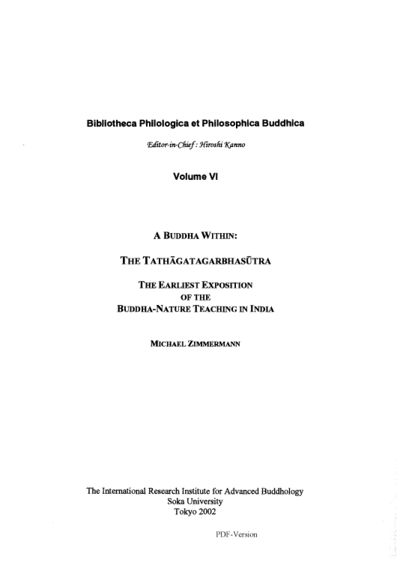- Preface7
- Acknowledgements8
- Technical Note: My Use of the Asterisk10
- I A Study and Annotated Translation of the Tathāgatagarbhasūtra11
- A General Study and Text-historical Considerations12
- 1 Textual History and Structure of the TGS16
- 1.1 Different Recensions of the TGS16
- 1.2 The Representatives of TGS224
- 1.3 Similarities between the Chinese Translations27
- 1.4 Structure, Contents and Textual History of the TGS27
- 1.5 The Structure, Nature and Contents of the Nine Similes34
- 2 The Meaning and Occurrences of the Term tathāgatagarbha39
- 2.1 The Term tathāgatagarbha39
- 2.2 The Textual Occurrences of the Terms tathāgatagarbha and
garbha46
- 3 The Buddha-Nature Doctrine in the TGS50
- 3.1 The Buddha-Nature50
- 3.2 Becoming a Buddha62
- 3.3 How to Become a Buddha65
- 4 The TGS as a Part of lndian Buddhism: Its Sources, Motives and
Reception67
- 4.1 The Titles of the TGS68
- 4.2 The Recorded Chinese Translations of the TGS69
- 4.3 Possible Motives of the Authors of the TGS75
- 4.4 The TGS in the History of lndian Buddhism77
- 4.5 The TGS in the Ratnagotravibhāga(vyākhyā) and Other Indian
Texts84
- 4.6 The Twentieth-Century Reception of the TGS90
- B An Annotated Translation of the Tathāgatagarbhasūtra into English 93
- II Critical and Diplomatic Editions of the Tathāgatagarbhasūtra163
- C The Textual Materials164
- 1 Information on the Tibetan Manuscripts and Xylographic Editions
Utilized164
- A The Tabo Manuscript Fragments164
- B -The Berlin Manuscript Kanjur165
- Bth - The Newark Manuscript Kanjur from Bathang166
- Bu - The Citation in Bu ston Rin chen grub's De bzhin gshegs pa 'i
snying po gsal zhing mdzes par byed pa 'i rgyan167
- D - The Derge Kanjur (Nyingma Edition)167
- J - The 'Jang sa tham or Lithang Kanjur168
- L-The Shel dkar Manuscript Kanjur (London)169
- N - The Narthang Kanjur 169
- P1, Pi, P1 - The Phug brag Ms Kanjur170
- Q - The Peking Kanjur (Otani Reprint)171
- S The Stog Palace ManuscriptK anjur171
- T- The Tokyo Manuscript Kanjur172
- 2 The Stemmatic Relations among the Representatives of Tib172
- 2.1 The Three Phug brag Versions 173
- 2.2 The Kanjurs of the Tshal pa Lineage 177
- 2.3 The Them spangs ma Kanjurs186
- 2.4 The Position of Bu191
- 2.5 The Position of A192
- 2.6 The Relation of the Main Transmissional Groups to Each
Other 193
- 2.7 Possible Stemmas of Tib203
- 3 Characteristics of the Textual Witnesses of Tib207
- 3.1 Archaic Features207
- 3.2 Irregular Verbal Forms208
- 3.3 Colophons and Translators210
- 4 A Brief Evaluation of the Chinese Materials213
- 5 Remarks on the Various Editions214
- 5. I Principles Governing the Critical Edition of Tib214
- 5 .2 Remarks on All Editions and Their Critical Apparatuses215
- 5.3 The Editions of the Tibetan Translations216
- 5.4 The Chinese Editions218
- D The Editions221
- The Critical and Diplomatic Editions221
- Apparatus of Secondary Variants370
- Sigla, Symbols and Graphic Devices of the Tibetan Material391
- Sigla and Graphic Devices of the Chinese Material392
- E Appendices395
- Appendix A: Comparative Chart of the Bodhisattva Names in OE396
- Appendix B: Comparative Chart of Pada Sequences398
- Appendix C: Comparative Table of Sections and Chapters of the
Chinese and Tibetan Editions400
- Bibliography405
- Primary Sources, with Abbreviations405
- Select Secondary Sources412
- Index427
A Buddha Within is a study and translation of the Tathāgatagarbha Sūtra, one of the earliest Indian scriptures to promote buddha-nature. The short sūtra contains nine similes for buddha-nature that can be divided into two categories: potential and perfected. These include the metaphor of a seed and gold hidden under a poor person's house. In the first, buddha-nature must be grown and developed; in the second, it is already perfected and must only be revealed. In both cases, however, buddha-nature is already present, and no fundamental transformation is needed to become a buddha: the promise is made that buddhahood is already present in all sentient beings. Zimmerman argues that the sūtra is best read as an ethical treatise, an encouragement to pursue enlightenment.
The first one hundred pages of the book are Zimmerman's commentary on the sūtra and its place in Indian, Chinese, and Tibetan Buddhism. He argues that there were two recensions of the scripture in India, the earliest of which went to China, and the later translated fourteen times into Tibetan. Key to his argument is that the Chinese translations do not contain the first simile of a pure white lotus growing in a muddy swamp. This, the sole passage to use the terms tathāgatagarbha, was thus added later, after the term had gained popularity.
Zimmerman surveys the doctrinal issues raised by the scripture, including the relationship between buddha-nature theory and Yogacāra in China, and zhentong and rangtong in the Tibetan context. The remainder of the book is an analysis of each recension and translation, an English translation incorporating all recensions and translations, and a critical edition of the Tibetan and Chinese. There is no surviving Sanskrit version.
Son of a good family, the True Nature (dharmatā) of the dharma is this: whether or not tathāgatas appear in the world, all these sentient beings contain at all times a tathāgata. Mahāyānottaratantraśāstra verse 73 line 11-12.
~ Buddha in A Buddha Within: The Tathāgatagarbhasūtra, page(s) 40
The Tathāgatagarbhasūtra (TGS) is a relatively short text that represents the
starting point of a number of works in Indian Mahayana Buddhism centering
around the idea that all living beings have the buddha-nature. The genesis of the
term tathāgatagarbha (in Tibetan de bzhin gshegs pa 'i snying po, in Chinese rulai zang 如來藏), the key term of this strand of Buddhism and the title of the sūtra, can be observed in the textual history of the TGS.
~ Zimmermann, M. in A Buddha Within: The Tathāgatagarbhasūtra, page(s) 7


